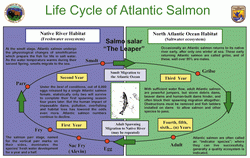Bibliography Background About KRIS
Introduction to Atlantic Salmon Life Cycle
Atlantic salmon (Salmo salar) have a unique life history known as anadromous, in which they are born in fresh water, live their adult lives in the ocean, and return to fresh water to reproduce. To thrive, Atlantic salmon require rivers and streams with adequate flow, cool water, and high dissolved oxygen levels. The diagram at the left shows details on the salmon life cycle (click to enlarge).
EGGS - Pea-sized orange eggs are deposited in riverbed gravel in autumn, and hatch the following early spring. As the eggs develop, the eyes of the developing wild salmon can be seen through the semi-transparent membrane.
ALEVIN - The partly transparent alevin hatch and remain hidden in the riverbed gravels, feeding from the attached yolk sac. They are about 2 cm or less than 1 inch in length.
FRY - Wriggling up from the gravels, fry begin feeding on microscopic life in the stream. They eventually reach a length of 5 to 8 cm./2 to 3in. before transforming into parr.
PARR - The vertical markings, called 'parr marks' appear, with a single red dot between. Parr remain in the river for 2 to 6 years, depending on water temperatures and food availability.
SMOLT - At a length of 12 to 24 cm/4.7 to 9.5 in. a springtime transformation of the parr takes place into smolt. A silvery sheen replaces the parr marks, and internally they undergo a complex transformation to survive in saltwater. On the downstream journey the odors of the smolt's native river are imprinted on its memory, to be recalled when it returns to spawn.
ADULT - Silvery hunters, adult wild salmon live one or more years at sea. Most populations follow lengthy migration routes to waters off southwestern Greenland where they grow rapidly on a diet of crustaceans and small fish. Other feeding grounds exist, such as waters surrounding the Faroe Islands north of Scotland, and some populations may stay closer to home rivers, such as those from the inner Bay of Fundy Rivers. Wild salmon that return after one year at sea are called grilse.
Adult salmon return to home rivers, entering freshwater between April and November. Once in freshwater they stop feeding, living off accumulated fat reserves.
In late fall the wild Atlantic salmon spawn. The female digs a 10-30cm/4-12 in. deep nest called a REDD in the gravel bottom of the stream. Her eggs and the milt from an adult male are released into the redd, the gravel replaced with additional tail thrusts. In some cases sexually mature male parr manage to fertilize a percentage of the eggs. In the painting parr are seen swimming nearby, looking for an opportunity. The female may lay 1,500 eggs or more for each kg./2.2 lb of body weight. - Thus a 12 pound female salmon will lay about 8,000 eggs, completing the life cycle.
Note: most of the contents of this page were adapted from the Atlantic Salmon Federation web site

